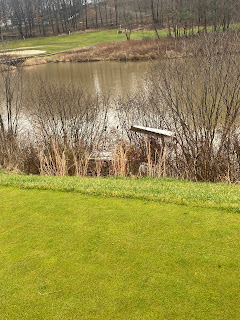We've received 3.82" of rain from 9 weather events over the first 15 days this month. Our historical average total precipitation for July is 3.90" so we're hoping for some dry weather the second half of the month. The amount of rain has presented some challenges, but all the drainage projects, regular aerification, and sand topdressing are keeping the courses in good condition. It's the high humidity and nighttime temperatures in the upper 60's/low 70's over the past two weeks that are really affecting the turf.
Similar to how our skin feels sticky when it's humid, turf is affected the same way and grows best in drier conditions. Humid weather prevents excess moisture from evaporating off the leaf blades and out of the soil, creating lush, soft conditions that frustrate golfers and turf managers. When combined with warmer temperatures, the excess moisture creates a perfect environment for turf diseases which must be treated with fungicides. Our most common summer disease is Dollar Spot and is easily identified by the light tan, circular spots that start out about the size of a silver dollar. As the disease progresses, the spots will bleed into each other and form larger, irregular patches that can be several feet in diameter. Dollar Spot is one of the easiest diseases to control and does not result in widespread turf loss if treated early. During the summer, we spray fungicides preventively for Dollar Spot every 14 days on greens, 14-21 days on tees, and 21-28 days on fairways depending on weather conditions. This week we had to spray fairways to control Dollar Spot after only 17 days since the last application due to the increased disease pressure caused by the wet weather. Two different chemistries were applied for a quick knockdown of the disease combined with longer residual control provided by a systemic fungicide that is absorbed by the plant. Several fertility products were also included in the spray to help the infected turf recover and produce new leaf tissue. In case you're wondering, we maintain 40 acres of fairways and this one application cost $12,000.
 |
| Lakes #9 fairway. Dollar Spot is easily identified by the tan colored spots and irregular shaped patches. |
 |
| Grove #6 rough. If your home lawn looks like this you may have active Dollar Spot. We typically spray the rough several times per season to control Dollar Spot and Gray Leaf Spot. |























































